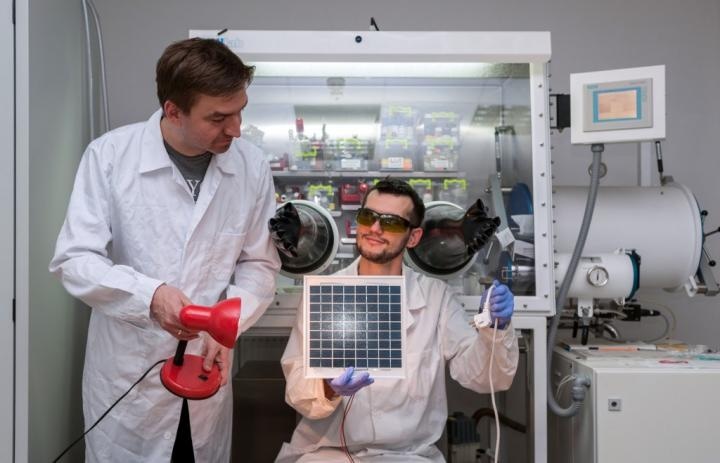Nov 8 2017
For several years, the commercialization of perovskite photovoltaic cells has gained immense attention. At present, the hot news is that devices developed by using these materials can transform solar energy into electricity with a higher efficiency like never before. However, there is one restriction—rather than synthesizing perovskites by conventional solution techniques, grinding should be the method of choice.
 The laboratory photovoltaic cells, working on perovskite materials obtained by mechanochemistry, convert solar energy into electricity even more efficiently. CREDIT: IPC PAS, Grzegorz Krzyzewski.
The laboratory photovoltaic cells, working on perovskite materials obtained by mechanochemistry, convert solar energy into electricity even more efficiently. CREDIT: IPC PAS, Grzegorz Krzyzewski.
Unrivaled outcomes can be achieved through collaboration between scientists with basic knowledge of chemistry and experienced technologists. A Swiss-Polish group from the Institute of Physical Chemistry of the Polish Academy of Sciences (IPC PAS) in Warsaw and the Ecole Polytechnique Federale de Lausanne (EPFL) in Lausanne (Switzerland) collaborating for the GOTSolar project, executed as part of the FET Open (Future and Emerging Technologies) program in Horizon 2020, has developed a perovskite cell with considerably fewer structural flaws. The unanticipated increase in the photovoltaic potential was noticed when perovskites synthesized through mechanochemistry were adopted for developing a usual photovoltaic cell.
Mechanochemistry is a fast evolving area of science concerning direct chemical reactions between solid-phase compounds when they are activated through mechanical force. In labs, these procedures are performed in automatic ball mills. Yet, we can successfully carry out certain mechanochemical reactions at home through manual grinding in standard mortars.
Perovskites belong to a broad class of materials with a cubic crystalline structure. Their general chemical formula is ABX3. Atoms of the element A are positioned at the cube’s center, an X atom is located in the middle of each wall, and the atoms of B occupy the corners. This class of materials gets its name from a naturally existing mineral calcium titanate, or CaTiO3, which was named as perovskite after Leo Perovski, a Russian geologist. As years passed, researchers discovered that the physicochemical characteristics of this class of material can be enhanced by substituting other elements in the place of calcium, titanium, and oxygen.
At present, the most usually analyzed compound of the perovskite class of materials is (CH3NH3)PbI3. Here, methylammonium (for A), lead (for B), and iodide (for X) ions respectively replace calcium, titanium and oxygen ions.
Professor Janusz Lewinski from IPC PAS, Warsaw University of Technology, and his colleagues were the pioneers in showing that polycrystalline halide perovskites, for example, the above-mentioned (CH3NH3)PbI3, can be synthesized through mechanochemical reactions. Recently, the team has also demonstrated the mechanochemical synthesis of mixed perovskites, or perovskites where various different ions alternate in the location of A. This is a significant accomplishment since these materials can be used for particular applications in catalysis, photovoltaics and other areas of science and technology through cautious modification of their chemical composition.
In practice, the mechanochemical production of our perovskites is as follows. Two powders, e.g. white methylammonium iodide CH3NH3I and yellow lead iodide PbI2, are placed in a mill equipped with a few steel balls. Then, we grind them for several dozen minutes and ... we pour out a homogeneous black powder of the perovskite (CH3NH3)PbI3, which can be directly used for the construction of photovoltaic cells. You do not need to use high temperature, organic solvents, or worry about waste. The whole process is really fast and efficient. It is green chemistry.
Marcin Saski, PhD student, IPC PAS
Professor Lewinski and his colleagues are pioneers in carrying out academic studies on the production of perovskites in Poland. The materials synthesized here are assembled and investigated at EPFL in partnership with Professor Michael Graetzel, a world-renowned Swiss chemist. Professor Graetzel is a specialist in nano- and mesomaterials for optoelectronics.
One of his exceptional accomplishments was the designing, in 1991, of an innovative kind of solar cell in which the transformation of solar energy into electric current is achieved by using an appropriate dye. At present, these cells are called Dye-Sensitized Solar Cells (DSSCs), or just Graetzel cells.
The laboratory photovoltaic cells operated by using perovskite materials synthesized through mechanochemistry have only recently been developed by Dr Daniel Prochowicz (EPFL, IPC PAS). Fascinatingly, a perovskite layer measuring a mere ~300 nm was adequate for its effective functioning. In the future, this thin coverage will considerably decrease the unit cost for cell production.
An important property characterizing the quality of a photovoltaic cell is the amount of electrical charge accumulating at the boundary of individual cell layers. If there is too much, the cell undergoes degradation more rapidly. Perovskites obtained by mechanochemistry formed a very homogeneous layer, which reduced the number of defects in the structure impairing the work of the cell and reduced the amount of charge deposited on the surface.
Dr. Prochowicz, Professor Graetzel’s team
What makes grinding the effective way to acquire the electrical characteristics of perovskite cells? This question remains unanswered to date. The solvent adopted for synthesizing perovskites appears to have a negative role. It can be included in the material’s structure, and when the perovskite is deposited on the substrate, its residues might lead to defect formation in the crystalline structure. Electrical and microscopic analyzes have demonstrated that the quality of mechanochemically produced perovskites, synthesized without using solvents, can be improved by decreasing the number of traps for charge carriers formed at the material’s junction with the substrate.
The study was performed as part of two projects of the Horizon 2020 program of the European Union. GOTSolar is a part of FET Open action, one among the most prestigious grants for international consortia of companies and academic institutions for developing ultra-modern technologies on the early stage. The goal of GOTSolar is to develop an innovative class of stable and efficient perovskite solar cells. Additional portion of this research was part of a Maria Sklodowska-Curie Individual Fellowship (MSCA IF)—a prestigious scholarship awarded to young postdoctoral researchers.